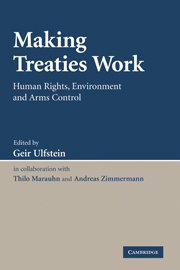Book contents
- Frontmatter
- Contents
- Preface and acknowledgments
- Notes on the contributors
- Table of cases
- Table of treaties and other international instruments
- INTRODUCTION
- PART I INTERNATIONAL HUMAN RIGHTS
- PART II INTERNATIONAL ENVIRONMENTAL LAW
- PART III INTERNATIONAL ARMS CONTROL
- 10 Dispute resolution, compliance control and enforcement of international arms control law
- 11 The Convention on the Prohibition of the Development, Production, Stockpiling and Use of Chemical Weapons and on their Destruction (Chemical Weapons Convention)
- 12 The Treaty on the Non-Proliferation of Nuclear Weapons (NPT) and the IAEA Safeguards Agreements
- 13 The Convention on the Prohibition of the Use, Stockpiling, Production and Transfer of Anti-Personnel Mines and on their Destruction (Ottawa Convention)
- GENERAL COMMENTS
- Index
13 - The Convention on the Prohibition of the Use, Stockpiling, Production and Transfer of Anti-Personnel Mines and on their Destruction (Ottawa Convention)
Published online by Cambridge University Press: 05 September 2009
- Frontmatter
- Contents
- Preface and acknowledgments
- Notes on the contributors
- Table of cases
- Table of treaties and other international instruments
- INTRODUCTION
- PART I INTERNATIONAL HUMAN RIGHTS
- PART II INTERNATIONAL ENVIRONMENTAL LAW
- PART III INTERNATIONAL ARMS CONTROL
- 10 Dispute resolution, compliance control and enforcement of international arms control law
- 11 The Convention on the Prohibition of the Development, Production, Stockpiling and Use of Chemical Weapons and on their Destruction (Chemical Weapons Convention)
- 12 The Treaty on the Non-Proliferation of Nuclear Weapons (NPT) and the IAEA Safeguards Agreements
- 13 The Convention on the Prohibition of the Use, Stockpiling, Production and Transfer of Anti-Personnel Mines and on their Destruction (Ottawa Convention)
- GENERAL COMMENTS
- Index
Summary
Since the Convention on the Prohibition of Anti-Personnel Mines (also known as the Ottawa Convention) entered into force in 1999, its implementation has been characterized by a high degree of co-operation and transparency rarely seen in multilateral treaty regimes, at least in the disarmament and humanitarian fields in which the Convention is rooted. The treaty's success so far is a reflection of the success of its formal and informal mechanisms to oversee and support compliance, in particular of those created by States parties after the treaty's entry into force, and of the monitoring, advocacy and support provided by non-governmental and other organizations. These mechanisms have been driven by the political will of States parties, notably those States that were key players in the negotiation of the treaty, and by the active involvement of non-State actors, in particular the International Campaign to Ban Landmines (ICBL) and the International Committee of the Red Cross (ICRC), as well as UN agencies engaged in ‘mine action’.
The ‘compliance culture’ of the Ottawa Convention, including the significant role of non-State actors in monitoring and supporting implementation, can best be understood by reference to the unique negotiation process that led to its adoption. This paper will therefore begin with a brief presentation of the Convention's negotiating history, followed by an overview of its key obligations, achievements and challenges. It will then describe the compliance control mechanisms, both those provided by the Convention itself and those created by the States parties after it entered into force.
- Type
- Chapter
- Information
- Making Treaties WorkHuman Rights, Environment and Arms Control, pp. 324 - 348Publisher: Cambridge University PressPrint publication year: 2007
- 1
- Cited by



